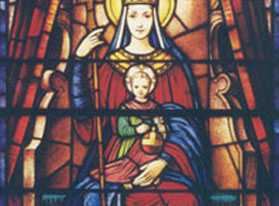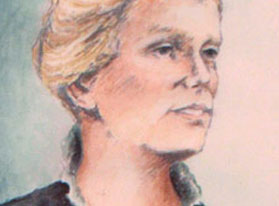Mercy Foundress
On 24th September each year, the feast of Our Lady of Mercy is celebrated throughout the world by Sisters of Mercy, a religious order of women founded by Catherine McAuley in Dublin, Ireland, in 1831. Mary, Mother of Jesus, is the one who through the sacrifice of her own heart had the deepest knowledge of the mystery of God's mercy. In this sense she is the Mother of Mercy, Our Lady of Mercy.
Catherine McAuley was born into a middle-class family in 1778 but by the time she reached adulthood she had witnessed the death of both parents and experienced considerable personal poverty. She was a deeply spiritual woman with a highly developed sense of social justice, fuelled by the desperate poverty she saw around her.
The sad plight of the young, unemployed and homeless girls at risk in Dublin haunted Catherine and when she inherited a substantial sum of money on the death of her 'adopted' parents, she decided to use it to build what we could call today a refuge for women and children. She called it a 'House of Mercy' and it was opened on the 24th September 1827. The house was referred to by some of her family as 'Kitty’s Folly' – a reflection of the criticism it evoked from some quarters in both Church and society.
My God, I am yours for all eternity; teach me to cast my whole self into the arms of your Providence with the most lively, unlimited confidence and compassionate, tender pity. Grant, O most Merciful Redeemer, that whatever you ordain or permit may always be acceptable to me; take from my heart all painful anxiety, suffer nothing to afflict me, but sin; nothing to delight me but the hope of coming to the possession of you, my God.
She soon gathered a group of well educated young women, eager to help her in this totally new notion of service to the poor, and the group began to look more and more like a religious order. The bishop advised her to take that step – which she had never envisaged nor desired – but which would give their way of life and their work in health, education and welfare canonical standing and stability. In her mature middle-age, Catherine was embarking on an unknown journey that would see the beginning of the new Institute of the Sisters of Mercy. She had just ten years to accomplish her work.
With two companions Catherine McAuley underwent the traditional formation of religious life and prepared to take vows of poverty, chastity and obedience at the Presentation Convent, George's Hill, Dublin. When the three were professed on 12th December 1831, Catherine's innovative spirit was strongly in evidence. She and her Sisters wanted to be free to walk among the poor, to be visible on the streets of Dublin, to have a profile of service that could not be ignored. They did not include the traditional fourth vow of enclosure and later, when the Rule of the Sisters of Mercy was approved, a fourth vow of service to the poor, sick and ignorant was added as a fitting reflection of the stated purpose and unique character of the Institute of the Sisters of Mercy. The presence of the Sisters among the poor, sick and dying, the neglected and oppressed – first in Dublin and then in other centres in Ireland and England, and eventually, in an amazingly short time, around the world – sparked a revolutionary attitudinal change to meeting the glaring needs of the time and earned them the title 'the walking nuns'.
Catherine's dream was being accomplished. The sick were visited in their homes and in the public hospitals. During the 1850's twenty-three Sisters of Mercy served in hospitals on the blood-sodden Crimean Peninsula. Florence Nightingale, who became a legend, learned much from the extensive nursing knowledge of this small band of Irish nuns. The Sisters saw to it that women and children were protected, safely housed and empowered with skills that helped restore their dignity and opened up opportunities for employment. In the many schools established, young people were led to an awareness of the evils of poverty and oppression and social injustice and challenged to accept, along with the Sisters, their responsibility 'to make a difference'.
Catherine was a woman ahead of her time. She had encountered God in the scriptures long before reading the Bible was promoted to Catholic laity or religious congregations. Taking the Word of God as her guide, the Gospel of Jesus was the only model she offered her new community. The spirit of mercy that Catherine handed down to her Sisters then is that of the mercy of Jesus revealed in his daily close and intimate contact with individuals in all levels of society and his healing response to need. For Catherine it was not enough to feel compassion, she was called to Mercy – compassion in action – flowing out of her God and her love of His afflicted ones.
'The poor need help today, not next week', she was wont to say as she established for her Sisters a tradition of practical help that continues to operate today in areas of contemporary need.
In those early years, faraway places like Australia, America and Argentina were developing countries, and Mercy Sisters were quick to accept the challenge of new needs. Foundations were made in Pittsburgh, USA, in 1843, in Perth, Australia, in 1846, in Auckland, New Zealand, in 1850, and in Argentina, South America, in 1856. Today Sisters of Mercy are found also in Papua New Guinea, Sudan, the Philippines, Pakistan, Peru, various parts of Africa and Asia and in the many refugee camps and detention centres where the developing world calls for Mercy.
The Parish of St Patrick's, Sydney, became part of the Mercy global story when Elizabeth McQuoin (Mother Mary Ignatius) arrived in Sydney in 1865 and accepted Archbishop Polding's invitation to make a Mercy foundation there. When the Marist Fathers took over the parish after the death of Archdeacon McEncroe in 1868, the Mercy Sisters continued their work with the people and co-operated with the Marist Fathers wholeheartedly in building up a faith community. When the Jesuits took over the Parish of St Mary's, North Sydney, in 1878, they found the Sisters of Mercy already established there since 1874. These groups of religious worked together in developing a lively and close-knit community joined in prayer, loving service and generous sharing and support. It was from these two centres of Mercy work that the Sisters, in the spirit of Catherine McAuley under the leadership of Elizabeth McQuoin, branched into other parts of wider Sydney and even beyond Australia.
God in His loving providence has watched over this group of Sisters of Mercy as He watched over Catherine and her early followers. For all that we give thanks. We remember Elizabeth's final call to us 'Be generous to the end', and we constantly pray Catherine McAuley's offering. It reflects her simple faith and trust in God as the mainspring of all her action and the fixed centre of her being:
This prayer has become the offering of every Sister of Mercy and is very similar to that of St Ignatius of Loyola, Elizabeth McQuoin's much loved and emulated patron. Adaptations of it in a number of languages have been set to music and Sisters of Mercy sing it in celebration of their rich Mercy tradition of trust in the unfailing providence of God.


